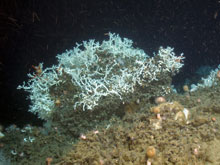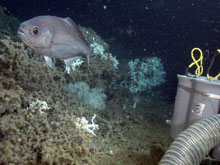On Closer Look: A New Discovery!
September 3, 2009
Chuck Fisher
Expedition Chief Scientist
Even when working in what we would consider a well-known area, we can be quickly get reminded of how little of the deep-sea floor we have actually seen. Last night, we dived in a general area we have visited several times before, over the course of four different research expeditions. But, this time we decided to explore a “mini seamount” about 3 kilometers (about 2 miles) south of where we first discovered corals in 2004. This little hill is only about 25 m (82 ft) high and about 150 m (492 ft) in diameter at its top. What we found on the top was amazing! Lophelia, black coral, and anemones were everywhere we looked, providing a rich habitat for crabs and fish of many different species. This small feature on our map turned out to support some of the biggest mounds of Lophelia we’ve ever seen in the Gulf of Mexico: A true deep-sea coral reef.
Although our intention was to make a quick stop here on our way to areas where we knew we could find corals for our research, we quickly revised our dive plan and spent almost our entire dive time (about 24 hours) exploring, mapping, sampling, and photographing the entire feature. At the end of the day, we were once again reminded of how little we know of the vast deep sea realm — and how exciting deep-sea research can be.






























